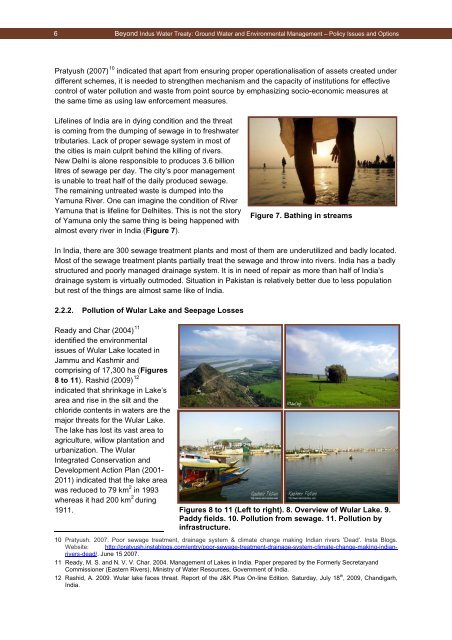Beyond Indus Water Treaty - IUCN
Beyond Indus Water Treaty - IUCN
Beyond Indus Water Treaty - IUCN
You also want an ePaper? Increase the reach of your titles
YUMPU automatically turns print PDFs into web optimized ePapers that Google loves.
6 <strong>Beyond</strong> <strong>Indus</strong> <strong>Water</strong> <strong>Treaty</strong>: Ground <strong>Water</strong> and Environmental Management – Policy Issues and Options<br />
Pratyush (2007) 10<br />
indicated that apart from ensuring proper operationalisation of assets created under<br />
different schemes, it is needed to strengthen mechanism and the capacity of institutions for effective<br />
control of water pollution and waste from point source by emphasizing socio-economic measures at<br />
the same time as using law enforcement measures.<br />
Lifelines of India are in dying condition and the threat<br />
is coming from the dumping of sewage in to freshwater<br />
tributaries. Lack of proper sewage system in most of<br />
the cities is main culprit behind the killing of rivers.<br />
New Delhi is alone responsible to produces 3.6 billion<br />
litres of sewage per day. The city’s poor management<br />
is unable to treat half of the daily produced sewage.<br />
The remaining untreated waste is dumped into the<br />
Yamuna River. One can imagine the condition of River<br />
Yamuna that is lifeline for Delhiites. This is not the story<br />
of Yamuna only the same thing is being happened with<br />
almost every river in India (Figure 7).<br />
Figure 7. Bathing in streams<br />
In India, there are 300 sewage treatment plants and most of them are underutilized and badly located.<br />
Most of the sewage treatment plants partially treat the sewage and throw into rivers. India has a badly<br />
structured and poorly managed drainage system. It is in need of repair as more than half of India’s<br />
drainage system is virtually outmoded. Situation in Pakistan is relatively better due to less population<br />
but rest of the things are almost same like of India.<br />
2.2.2. Pollution of Wular Lake and Seepage Losses<br />
Ready and Char (2004) 11<br />
identified the environmental<br />
issues of Wular Lake located in<br />
Jammu and Kashmir and<br />
comprising of 17,300 ha (Figures<br />
8 to 11). Rashid (2009) 12<br />
indicated that shrinkage in Lake’s<br />
area and rise in the silt and the<br />
chloride contents in waters are the<br />
major threats for the Wular Lake.<br />
The lake has lost its vast area to<br />
agriculture, willow plantation and<br />
urbanization. The Wular<br />
Integrated Conservation and<br />
Development Action Plan (2001-<br />
2011) indicated that the lake area<br />
was reduced to 79 km 2 in 1993<br />
whereas it had 200 km 2 during<br />
1911.<br />
Figures 8 to 11 (Left to right). 8. Overview of Wular Lake. 9.<br />
Paddy fields. 10. Pollution from sewage. 11. Pollution by<br />
infrastructure.<br />
10 Pratyush. 2007. Poor sewage treatment, drainage system & climate change making Indian rivers 'Dead'. Insta Blogs.<br />
Website: http://pratyush.instablogs.com/entry/poor-sewage-treatment-drainage-system-climate-change-making-indianrivers-dead/.<br />
June 15 2007.<br />
11 Ready, M. S. and N. V. V. Char. 2004. Management of Lakes in India. Paper prepared by the Formerly Secretaryand<br />
Commissioner (Eastern Rivers), Ministry of <strong>Water</strong> Resources, Government of India.<br />
12 Rashid, A. 2009. Wular lake faces threat. Report of the J&K Plus On-line Edition. Saturday, July 18 th , 2009, Chandigarh,<br />
India.

















